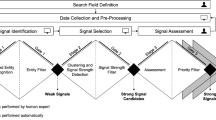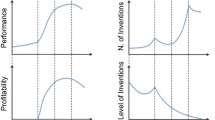Abstract
Corporate foresight comprises all activities that are aimed at identifying changes on the basis of early signals in trends, creating a consolidated future outlook, and using these insights into the future in ways useful to the organization. These activities include developing a strategy, creating innovations, managing risk, and exploring new markets. The author identifies five challenges that companies may face when developing corporate foresight, which include the detection of signals that yield a competitive advantage, the detection of change when terminology is unclear, and the selection of an appropriate foresight method as well as the successful use of foresight methods in the highly iterative front end of innovation. Monitoring and scanning are two ways of conducting the search, with intelligent data mining and scouting networks as possible approaches. Foresight methods can be divided into methods suitable for exploring the future on the market side and methods more suitable for the technology aspect. Thinking in scenarios is a good choice when direction and rate of change are unknown.
Access this chapter
Tax calculation will be finalised at checkout
Purchases are for personal use only
Similar content being viewed by others
References
Ansoff IH (1975) Managing strategic surprise by response to weak signals. Calif Manage Rev 18(2):21–33
Backman M, Borjesson S, Setterberg S (2007) Working with concepts in the fuzzy front end: exploring the context for innovation for different types of concepts at Volvo Cars. R&D Manage 37(1):17–28
Bergmann I, Butzke D, Walter L, Fürste J-P, Möhrle MG, Erdmann VA (2008) Evaluating the risk of patent infringement by means of semantic patent analysis: the case of DNA-chips. R&D Manage 38(5):550–562
Chandy RK, Tellis GJ (2000) The incumbent’s curse? Incumbency, size, and radical product innovation. J Market 64(3):1–17
Daft RL, Weick KE (1984) Toward a model of organizations as interpretation systems. Acad Manage Rev 9(2):284–295
Gausemeier J, Fink A, Schlake O (1998) Scenario management: an approach to develop future potentials. Technol Forecast Soc Change 59(2):111–130
Gemünden HG (2001) Die Entstehung von innovationen: Eine Diskussion theoretischer Ansätze. In: Hamel W, Gemünden H-G (eds) Außergewöhnliche Entscheidungen – Festschrift für Jürgen Hauschildt. Vahlen, München, pp 409–440
Gordon S, Tarafdar M, Cook R, Maksimoski R, Rogowitz B (2008) Improving the front end of innovation with information technology. Res Technol Manage 51(3):50–58
Griffin A, Hoffmann N, Price RL, Vojak BA (2007) How serial innovators navigate the fuzzy front end of new product development. Paper presented at the PDMA research conference
Heger T, Rohrbeck R (2012) Strategic foresight for collaborative exploration of new business fields. Technol Forecast Soc Change 79(5):819–831
Khurana A, Rosenthal SR (1998) Towards holistic “front ends” in new product development. J Prod Innov Manage 15(1):57–74
Koen P, Ajamian G, Burkart R, Clamen A, Davidson J, D’Amore R, Elkins C, Herald K, Incorvia M, Johnson A, Karol R, Seibert R, Slavejkov A, Wagner K (2001) Providing clarity and a common language to the fuzzy front end. Res Technol Manage 44(2):46–55
Nijssen EJ, Hillebrand B, Vermeulen PAM (2005) Unraveling willingness to cannibalize: a closer look at the barrier to radical innovation. Technovation 25(12):1400–1409
Porter AL, Ashton WB, Clar G, Coates JF, Cuhls K, Cunningham SW, Ducatel K, van der Duin P, Cunningham SW, Ducatel K, van der Duin P, Georgehiou L, Gordon T, Linstone H, Marchau V, Massari G, Miles I, Mogee M, Salo A, Scapolo F, Smits R, Thissen W, Group TFAMW (2004) Technology futures analysis: toward integration of the field and new methods. Technol Forecast Soc Change 71(3):287–303
Reger G (2001) Technology foresight in companies: from an indicator to a network and process perspective. Technol Anal Strateg Manage 13(4):533–553
Rohrbeck R (2010a) Corporate foresight: towards a maturity model for the future orientation of a firm. Physica-Verlag/Springer, Heidelberg
Rohrbeck R (2010b) Harnessing a network of experts for competitive advantage – technology scouting in the ICT industry. R & D Manage 40(2):169–180
Rohrbeck R, Gemünden HG (2011) Corporate foresight: its three roles in enhancing the innovation capacity of a firm. Technol Forecast Soc Change 78(2):231–243
Rohrbeck R, Schwarz JO (2013) The value contribution of strategic foresight: insights from an empirical study of large European Companies. Technological forecasting and social change, forthcoming, available at SSRN, http://ssrn.com/abstract=2194787
Rohrbeck R, Hölzle K, Gemünden HG (2009) Opening up for competitive advantage – how deutsche telekom creates an open innovation ecosystem. R & D Manage 39(4):420–430
Rohrbeck R, Konnertz L, Knab S (2013) Collaborative business modelling for systemic and sustainable innovations. Int J Technol Manage, forthcoming
Slaughter RA (1997) Developing and applying strategic foresight. ABN Rep 5(10):13–27
Verworn B, Herstatt C, Nagahira A (2008) The fuzzy front end of Japanese new product developmentprojects: impact on success and differences between incremental and radical projects. R&D Manage 38(1):1–19
Veugelers M, Bury J, Viaene S (2010) Linking technology intelligence to open innovation. Technol Forecast Soc Change 77(2):335–343
von Hippel E, Franke N, Prügl R (2008) “Pyramiding”: efficient identification of rare subjects. MIT Sloan School of Management Working Paper, pp 4719–08
Author information
Authors and Affiliations
Corresponding author
Editor information
Editors and Affiliations
Rights and permissions
Copyright information
© 2014 Springer International Publishing Switzerland
About this chapter
Cite this chapter
Rohrbeck, R. (2014). Trend Scanning, Scouting and Foresight Techniques. In: Gassmann, O., Schweitzer, F. (eds) Management of the Fuzzy Front End of Innovation. Springer, Cham. https://doi.org/10.1007/978-3-319-01056-4_5
Download citation
DOI: https://doi.org/10.1007/978-3-319-01056-4_5
Published:
Publisher Name: Springer, Cham
Print ISBN: 978-3-319-01055-7
Online ISBN: 978-3-319-01056-4
eBook Packages: Business and EconomicsBusiness and Management (R0)




